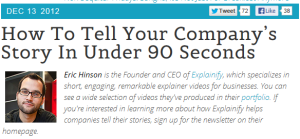Telling Your Story with Video: An Interview with Explanify’s Eric Hinson
 David: In a recent interview titled How to Tell Your Company’s Story in Under 90 Seconds, you noted how agencies are missing the boat because they aren’t telling stories. I see the same thing with employers who think they are engaging in employer branding by saying things like “When you work here, you get to work with great people with high integrity, you get to grow professionally…” etc etc. and all sorts of Corporate Speak. The end result is one company’s message is interchangeable with another’s. How does storytelling help employers set themselves apart?
David: In a recent interview titled How to Tell Your Company’s Story in Under 90 Seconds, you noted how agencies are missing the boat because they aren’t telling stories. I see the same thing with employers who think they are engaging in employer branding by saying things like “When you work here, you get to work with great people with high integrity, you get to grow professionally…” etc etc. and all sorts of Corporate Speak. The end result is one company’s message is interchangeable with another’s. How does storytelling help employers set themselves apart?
Eric: Stories make things exciting and memorable. The most exciting companies right now are the ones that tell stories about their culture. They convey their culture through blog posts, on their social channels and even on their website – not just by saying “1 week of paid vacation, benefits, etc” – we’re all use to that – but by showing what it’s like to work there.
Feel free to ride your scooters among offices and stop in at our cereal bar for some Frosted Flakes before that 1 o’clock meeting…er…I mean, ‘get together’. On the way, have a go on our colored slides, use our private phone rooms or chat about geekery next to our Star Wars decorated walls, among other things.
We’ve all seen pictures of Google’s awesome workplaces and share them because they’re memorable and exciting. It looks as though their culture is the DNA of the company, that work really isn’t “work” because it’s so fun. Work that isn’t work – Who can’t get excited about that? The stories (and images) are what get a prospect excited to work there. That sets their company apart from the “other guy” and is a lot more memorable (and potentially viral).
David: What about companies wanting to break through the media clutter, how does storytelling help them do that?
Eric: Stories are the way we all learned and connected to ideas since we were children. Almost everyone on the planet grew up listening to stories. Story defined us and were our form of entertainment. Our favorite times growing up often centered around storytime, and that hasn’t changed much. Storytelling stimulates more parts of the brain than any other communication.
What we hear is immediately connected with our personal experiences and we’re more likely to understand, remember, etc. Remember your grandpa’s war stories that brought forth feelings of anxiousness and nervousness? They kept you on the edge of your seat and you couldn’t wait to tell the other kids at school about how heroic Gramps was.
Tell a good story (a story that others think is good, not just you) and it will surface above the rest.
David: Can you talk about Explainify and how you are helping clients use visual stories to make their message more “sticky” to use Chip and Dan Heath’s term?
Eric: You can’t sell products if you’re not able to get a potential customer’s attention. We realized with businesses, there’s an epidemic of whitepapers, long business plans, and credentials being thrown around like confetti – but there isn’t anything being said that gets us as prospective customers excited enough to warrant that confetti being used. In fact, there’s a big gap between your boring business website and me signing up.
At Explainify, we wanted to address that gap and inject some fun into it. We help businesses capture the essence of what they do and turn it into a remarkable 60-90 second animated explainer video (or explanatory video) packed full of fun and strategic writing that converts and sells.
David: Why video and when might you use written story instead?
Eric: They say a picture is a worth a thousand words, so that makes video worth 1.8 million, according to Forrester Research. Can’t argue with proverbs mixed with research like that! Seriously though, 90% of online shoppers say that video helps them in their purchasing decision and 82% of internet users watch video online. We’re surrounded by video in our lives, so it’s a medium where we’re likely to get and keep their attention. In fact, a more illustrative style benefits information recall significantly over text. 80%!
That’s not to say written story isn’t effective, it’s just not our focus.
David: What would you like to say about what makes a story fascinating and what makes one Ho Hum?
Eric: A memorable story has to be simple, easy to follow and easy to recall. The problem with most businesses stories is that they think every detail has to be included. Think about a memorable billboard you saw driving down the road or an ad you saw sitting in the dentist’s office. What was remarkable about it? Its simplicity! It evoked emotion and wasn’t full of boring facts or details. Those aren’t too memorable. Facts are great, don’t get me wrong. Take those facts and spin them into one cohesive, memorable story.
David: Anything else you want to say to a business wanting to communicate in a more compelling way, whether to the marketplace or to the labor market?
Eric: You’ve got to break up the monotony. You’ve got to do something different than your competition. Be adventurous. Be bold. Be daring. Be offensive. Be creative.
We’ve seen simple animated explainer video facilitate quick understanding and interest among potential customers which leads to increased conversions, search engine results, and ultimately, real dollar sales. It’s pretty amazing what a well packaged (and presented) idea can do for your business. Don’t underestimate it and don’t undervalue it.
 Eric Hinson is the Founder and CEO of Explainify, which specializes in short, engaging, remarkable explainer videos for businesses. You can see a wide selection of videos they’ve produced in their portfolio. If you’re interested in learning more about how Explainify helps companies tell their stories, sign up for the newsletter on their homepage.
Eric Hinson is the Founder and CEO of Explainify, which specializes in short, engaging, remarkable explainer videos for businesses. You can see a wide selection of videos they’ve produced in their portfolio. If you’re interested in learning more about how Explainify helps companies tell their stories, sign up for the newsletter on their homepage.
